A hybrid numerical scheme for singularly perturbed parabolic differential-difference equations arising in the modeling of neuronal variability
Abstract
This study aims at constructing a robust numerical scheme for solving singularly perturbed parabolic delay differential equations arising in the modeling of neuronal variability. Taylor's series expansion is applied to approximate the shift terms. The obtained result is approximated by using the implicit Euler method in the temporal discretization on a uniform step size with the hybrid numerical scheme consisting of the midpoint upwind method in the outer layer region and the cubic spline in tension method in the inner layer region on a piecewise uniform Shishkin mesh in the spatial discretization. The constructed scheme is shown to be an -uniformly convergent accuracy of order . Two model examples are given to testify the theoretical findings.
1 INTRODUCTION
Since the past decade, some scholars have been developing robust numerical methods for the SPPDDE with shift parameter(s) and analyzing the effects of the shift parameters on the solution profile. The authors3-12 have developed different numerical methods based on fitting techniques (adaptive layer and fitted operator) for solving the SPPDDE with shift(s) in the space variable and elucidated the effect of the singular perturbation and shift parameter(s) on the solution profile. The authors13-16 have also suggested various robust numerical schemes for SPPDDE with time delay. Recently, the authors17-19 have presented higher-order a parameter uniform computational methods for singularly perturbed two-parameter parabolic convection–diffusion problems using a fitted operator. However, numerical methods to solve the SPPDDE with mixed small shifts in the spatial variable having an -uniform convergence for the past decades are still few. The main contribution of this study is to construct and analyze a robust numerical scheme to solve the families of the problem under consideration that arises in the modeling of neuronal variability. The formulation of the method and its corresponding error analysis are treated in the subsequent sections.
Standard supremum norm is denoted by and is defined by , for a function defined on some domain D.
2 CONTINUOUS PROBLEM
Lemma 1.(Maximum principle). Let . If () and , then .
Proof.See Reference 6.
Lemma 2. (Stability estimate)Let be the solution of Equation (5), then we have the estimation
Proof.Defining the barrier functions as
3 DESCRIPTION OF THE NUMERICAL SCHEME
To formulate the numerical scheme, we first discretize the temporal variable using the implicit Euler method on a uniform mesh.
3.1 Temporal discretization
Lemma 3. (Discrete maximum principle)Let . If and , then .
Proof.See Reference 11.
Lemma 4.Suppose , then the local error estimate in the temporal discretization at th time level satisfies
Proof.The detailed proof of this lemma is given in Reference 5.
Lemma 5.The global error estimate in the temporal direction of Equation (9) satisfies
Proof.From Lemma 4, we have
Theorem 1.The semidiscretize solution and its derivatives satisfy the following bounds:
Proof.See Reference 5.
3.2 Spatial discretization
Mesh selection strategy
3.2.1 Hybrid numerical scheme
In this subsection, we approximate Equation (9) by using the hybrid numerical scheme which is based on the midpoint upwind difference method in the outside layer region and cubic spline in tension method in the inside layer region.
Midpoint upwind method
, and .
Cubic spline in tension method
Now, we approximate the inside layer region of the resulting spatial equation (11) by applying the cubic spline in tension method as described below.
Since , the matrix is diagonally dominant with , , and and hence nonsingular and . This leads to the matrix is M-matrix and the scheme in (26) has a unique solution. Thus, the tridiagonal systems (26) can be solved using standard direct techniques at each time level.
Lemma 7. (Discrete maximum principle)If then implies .
Proof.The proof follows from similar arguments as used in Lemma 3.
Lemma 8. (Uniform stability estimate)The solution of the scheme in (24) satisfies
4 ERROR ANALYSIS
Theorem 2.Let be the solution of (5) and be the approximation to the solution of (25), then the following error bound holds
Proof.To estimate the error , we follow the following two cases:
Case 1: When , the mesh is uniform with and , which gives . By using Theorem 1 in Equations (33) and (34), we obtain
Case 2: When , the mesh is a piecewise uniform with in and in .
For the case , the region is regular region, that is, . From Lemma 6 we have
Using Equation (36) into Equation (34) we obtain
For the case , the region is boundary layer region, that is, , we have , which gives , therefore from Equation (33), we obtain
On combining Equations (37) and (38), we get
Again combining Equations (35) and (39), we obtain the required bound
5 NUMERICAL EXAMPLES AND RESULTS
The computed , and for Examples 1 and 2 are presented in Tables 1–6. As observed in Tables 1–6 the maximum pointwise errors decrease as the step sizes decrease for all values of , which confirms the robustness of the constructed scheme. Moreover, these tables show that the scheme in (25) provides more accurate numerical results than results in References 4, 7, 8.
| N = 32 | N = 64 | N = 128 | N = 256 | N = 512 | |
|---|---|---|---|---|---|
| M = 60 | M = 120 | M = 240 | M = 480 | M = 960 | |
| Present scheme | |||||
| 1.9430e03 | 1.0798e03 | 5.7232e04 | 2.9513e04 | 1.5091e04 | |
| 1.9426e03 | 1.0801e03 | 5.7368e04 | 2.9674e04 | 1.5129e04 | |
| 1.9424e03 | 1.0801e03 | 5.7373e04 | 2.9693e04 | 1.5129e04 | |
| 1.9423e03 | 1.0800e03 | 5.7373e04 | 2.9693e04 | 1.5129e04 | |
| 1.9423e03 | 1.0800e03 | 5.7373e04 | 2.9693e04 | 1.5129e04 | |
| 1.9423e03 | 1.0800e03 | 5.7373e04 | 2.9693e04 | 1.5129e04 | |
| Results in Reference 7 | |||||
| 6.0830e03 | 3.3134e03 | 1.7268e03 | 8.8122e04 | 4.4510e04 | |
| 6.0793e03 | 3.3114e03 | 1.7257e03 | 8.8067e04 | 4.4482e04 | |
| 6.0784e03 | 3.3108e03 | 1.7255e03 | 8.8053e04 | 4.4475e04 | |
| 6.0781e03 | 3.3107e03 | 1.7254e03 | 8.8050e04 | 4.4474e04 | |
| 6.0781e03 | 3.3107e03 | 1.7254e03 | 8.8049e04 | 4.4473e04 | |
| 6.0781e03 | 3.3107e03 | 1.7254e03 | 8.8049e04 | 4.4473e04 | |
| Results in Reference 8 | |||||
| 9.6961e03 | 4.8523e03 | 2.4275e03 | 1.2141e03 | 6.0716e04 | |
| 9.6933e03 | 4.8509e03 | 2.4268e03 | 1.2138e03 | 6.0698e04 | |
| 9.6927e03 | 4.8506e03 | 2.4266e03 | 1.2137e03 | 6.0694e04 | |
| 9.6927e03 | 4.8506e03 | 2.4266e03 | 1.2137e03 | 6.0694e04 | |
| 9.6927e03 | 4.8506e03 | 2.4266e03 | 1.2137e03 | 6.0694e04 | |
| 9.6927e03 | 4.8506e03 | 2.4266e03 | 1.2137e03 | 6.0694e04 | |
| N = 32 | N = 64 | N = 128 | N = 256 | N = 512 | |
|---|---|---|---|---|---|
| M = 60 | M = 120 | M = 240 | M = 480 | M = 960 | |
| Present scheme | |||||
| 3.6769e03 | 2.1519e03 | 1.1796e03 | 6.1951e04 | 3.1775e04 | |
| 3.6767e03 | 2.1518e03 | 1.1795e03 | 6.1948e04 | 3.1774e04 | |
| 3.6767e03 | 2.1517e03 | 1.1795e03 | 6.1947e04 | 3.1773e04 | |
| 3.6767e03 | 2.1517e03 | 1.1795e03 | 6.1947e04 | 3.1773e04 | |
| 3.6767e03 | 2.1517e03 | 1.1795e03 | 6.1947e04 | 3.1773e04 | |
| 3.6767e03 | 2.1517e03 | 1.1795e03 | 6.1947e04 | 3.1773e04 | |
| Results in Reference 4 | |||||
| 7.6373e03 | 3.8377 e03 | 1.9274 e03 | 9.6613 e04 | 4.8372 e04 | |
| 7.6385 e03 | 3.8382 e03 | 1.9277 e03 | 9.6624 e04 | 4.8378 e04 | |
| 7.6387 e03 | 3.8383 e03 | 1.9277 e03 | 9.6627 e04 | 4.8378 e04 | |
| 7.6388 e03 | 3.8384 e03 | 1.9277 e03 | 9.6627 e04 | 4.8379 e04 | |
| 7.6388 e03 | 3.8384 e03 | 1.9277 e03 | 9.6627 e04 | 4.8379 e04 | |
| 7.6388 e03 | 3.8384 e03 | 1.9277 e03 | 9.6627 e04 | 4.8379 e04 | |
| Results in Reference 8 | |||||
| 5.8119e03 | 3.1990e03 | 1.6733e03 | 8.5519e04 | – | |
| 5.8129e03 | 3.1995e03 | 1.6736e03 | 8.5532e04 | – | |
| 5.8132e03 | 3.1996e03 | 1.6737e03 | 8.5535e04 | – | |
| 5.8132e03 | 3.1996e03 | 1.6737e03 | 8.5536e04 | – | |
| 5.8132e03 | 3.1996e03 | 1.6737e03 | 8.5536e04 | – | |
| 5.8132e03 | 3.1996e03 | 1.6737e03 | 8.5536e04 | – | |
| N = 16 | N = 32 | N = 64 | N = 128 | N = 256 | |
|---|---|---|---|---|---|
| 4.8012e03 | 3.2278e03 | 1.8679e03 | 1.0199e03 | 5.3631e04 | |
| 4.8010e03 | 3.2276e03 | 1.8678e03 | 1.0199e03 | 5.3628e04 | |
| 4.8008e03 | 3.2274e03 | 1.8677e03 | 1.0198e03 | 5.3625e04 | |
| 4.8006e03 | 3.2272e03 | 1.8675e03 | 1.0198e03 | 5.3622e04 | |
| 4.8004e03 | 3.2270e03 | 1.8674e03 | 1.0197e03 | 5.3619e04 | |
| 4.7989e03 | 3.2255e03 | 1.8664e03 | 1.0192e03 | 5.3596e04 | |
| 4.7993e03 | 3.2259e03 | 1.8667e03 | 1.0194e03 | 5.3602e04 | |
| 4.7997e03 | 3.2263e03 | 1.8669e03 | 1.0195e03 | 5.3608e04 | |
| 4.8000e03 | 3.2267e03 | 1.8672e03 | 1.0196e03 | 5.3614e04 | |
| 4.8004e03 | 3.2270e03 | 1.8674e03 | 1.0197e03 | 5.3619e04 | |
| N = 16 | N = 32 | N = 64 | N = 128 | N = 256 | |
|---|---|---|---|---|---|
| 7.4227e03 | 5.4105e03 | 3.5033e03 | 2.0429e03 | 1.1121e03 | |
| 7.4227e03 | 5.4106e03 | 3.5034e03 | 2.0429e03 | 1.1122e03 | |
| 7.4227e03 | 5.4107e03 | 3.5034e03 | 2.0430e03 | 1.1122e03 | |
| 7.4227e03 | 5.4108e03 | 3.5035e03 | 2.0430e03 | 1.1122e03 | |
| 7.4227e03 | 5.4108e03 | 3.5036e03 | 2.0431e03 | 1.1123e03 | |
| 7.4227e03 | 5.4110e03 | 3.5037e03 | 2.0432e03 | 1.1123e03 | |
| 7.4227e03 | 5.4109e03 | 3.5036e03 | 2.0432e03 | 1.1123e03 | |
| 7.4227e03 | 5.4109e03 | 3.5036e03 | 2.0431e03 | 1.1123e03 | |
| 7.4227e03 | 5.4108e03 | 3.5036e03 | 2.0431e03 | 1.1123e03 | |
| 7.4227e03 | 5.4108e03 | 3.5036e03 | 2.0431e03 | 1.1123e03 | |
| N = 32 | N = 64 | N= 128 | N = 256 | N = 512 | |
|---|---|---|---|---|---|
| M = 20 | M = 40 | M = 80 | M = 160 | M = 320 | |
| Example 1 | |||||
| 7.4982e03 | 2.7629e03 | 1.5508e03 | 8.3192e04 | 4.3745e04 | |
| 7.4966e03 | 2.7627e03 | 1.5501e03 | 8.3505e04 | 4.3738e04 | |
| 7.4961e03 | 2.7626e03 | 1.5501e03 | 8.3521e04 | 4.3729e04 | |
| 7.4959e03 | 2.7625e03 | 1.5501e03 | 8.3521e04 | 4.3732e04 | |
| 7.4959e03 | 2.7625e03 | 1.5501e03 | 8.3521e04 | 4.3732e04 | |
| 7.4959e03 | 2.7625e03 | 1.5501e03 | 8.3521e04 | 4.3732e04 | |
| Example 2 | |||||
| 6.9295e03 | 4.5408e03 | 2.9466e03 | 1.6897e03 | 9.0583e04 | |
| 6.9294e03 | 4.5407e03 | 2.9465e03 | 1.6896e03 | 9.0576e04 | |
| 6.9294e03 | 4.5407e03 | 2.9464e03 | 1.6896e03 | 9.0576e04 | |
| 6.9294e03 | 4.5407e03 | 2.9464e03 | 1.6896e03 | 9.0576e04 | |
| 6.9294e03 | 4.5407e03 | 2.9464e03 | 1.6896e0 | 9.0576e04 | |
| 6.9294e03 | 4.5407e03 | 2.9464e03 | 1.6896e03 | 9.0578e4 | |
The effects of the (negative shift) and (positive shift) are shown in Figures 1(A,B) and 2(A,B) on the solution profiles for Examples 1 and 2. From these figures, we can observe that as the size of increases, the thickness of the layer increases (see Figure 1(A,B)), whereas as the size of increases, the thickness of the layer decreases (see Figure 2(A,B)). The 3D view of the numerical solution profiles for Examples 1 and 2 are displayed in Figures 3 and 4, respectively for , and . As it can be observed in Figures 3 and 4 as a strong boundary layer is formed near . In Figure 5(A,B), we have plotted a log-log plot of the verses N for Examples 1 and 2, respectively. As observed in Figure 5(A,B) the scheme in (25) is an -uniformly convergent and stable.
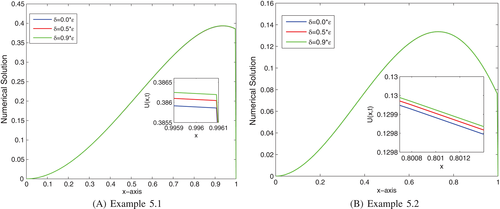
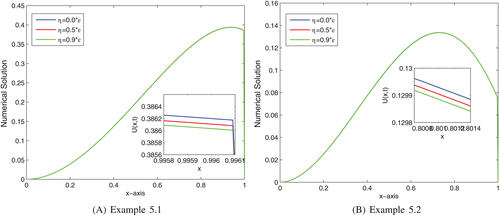
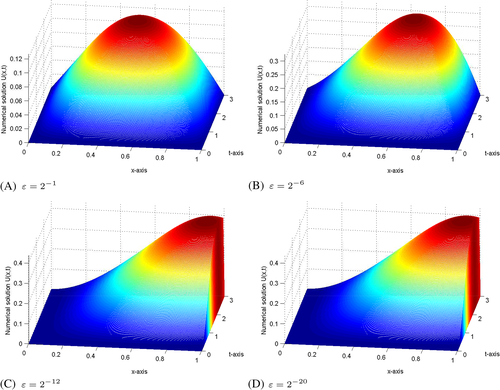
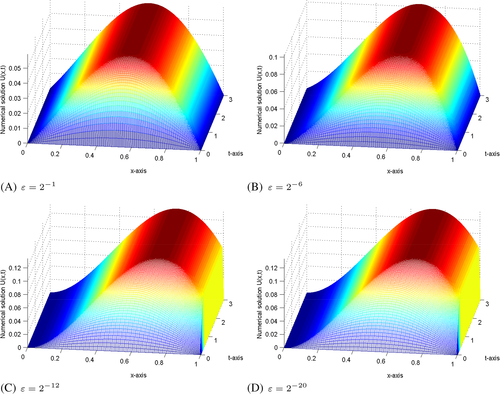
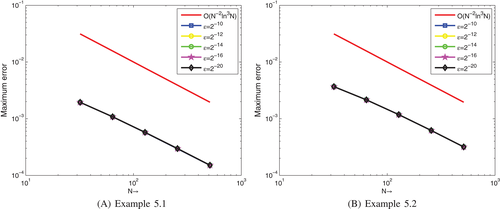
6 CONCLUSIONS
The robust numerical scheme is presented to solve the SPPDDEs arising in the modeling of neuronal variability. The scheme is proved to be an -uniformly convergent accuracy of order . The efficiency of the scheme is shown by taking two test examples and comparing them with the numerical results in References 4, 7, 8. Concisely, the presented scheme is simple, stable and provides more accurate numerical results than the others.
ACKNOWLEDGMENT
The authors are grateful to the anonymous referees and editor for their constructive comments that will improve the quality of this manuscript.
CONFLICTS OF INTEREST
The authors declare that they have no competing interests.
Biographies

Imiru Takele Daba received his M.Sc. from Haramaya University, Ethiopia and Ph.D. scholar at Wollega University, Department of Mathematics, College of Natural and Computational Sciences, Ethiopia. His research interests include numerical methods for singularly perturbed differential-difference equations. He has published four research article in international reputable journal.

Gemechis File Duressa received his M.Sc. from Addis Ababa University, Ethiopia and Ph.D. from National Institute of Technology, Warangal, India. He is currently working as an associate professor at Jimma University, Ethiopia. His research interests include numerical methods for singularly perturbed differential equations, differential equations in ODE and PDE. He has published more than 80 research articles in various international reputable journals.




